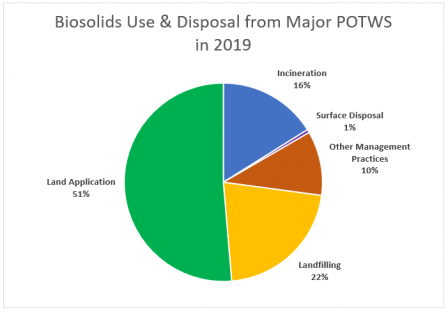Basic Information about Biosolids
Basics of Biosolids
Biosolids are a product of the wastewater treatment process. During wastewater treatment the liquids are separated from the solids. Those solids are then treated physically and chemically to produce a semisolid, nutrient-rich product known as biosolids. The terms ‘biosolids’ and ‘sewage sludge’ are often used interchangeably.
Biosolids that are to be beneficially used must meet federal and state requirements. Examples of beneficial use include application to agricultural land and reclamation sites (e.g. mining sites). When applied to land at the appropriate agronomic rate, biosolids provide a number of benefits including nutrient addition, improved soil structure, and water reuse. Land application of biosolids also can have economic and waste management benefits (e.g., conservation of landfill space; reduced demand on non-renewable resources like phosphorus; and a reduced demand for synthetic fertilizers). Biosolids also may be disposed of by incineration, landfilling, or other forms of surface disposal.
Biosolids Odors
Biosolids may emit a distinctive odor depending on the treatment process and methods used. The odorous compounds generated and detected most often are ammonia, amines, and reduced sulfur-containing compounds. Meteorological conditions such as wind speed and direction, relative humidity, and temperature can impact nuisance odors. The presence of biosolids odors does not mean that the biosolids pose harm to human health and the environment.
Classes of Biosolids
Existing requirements and guidance help ensure that biosolids are processed, handled, and land-applied in a manner that minimizes potential risk to human health. Biosolids are divided into “Class A” and “Class B” designations based on treatment methods. The different classes have specified treatment requirements for pollutants, pathogens and vector attraction reduction, as well as general requirements and management practices. 40 CFR Part 503 treatment processes for Class A biosolids eliminate pathogens, including viruses. Generally, pathogens may exist when requirements are met under 40 CFR Part 503 for Class B biosolids, which is why EPA’s site restrictions that allow time for pathogen degredation should be followed for harvesting crops and turf, for grazing of animals, and public contact.
Requirements for meeting Class A and Class B biosolids are determined by the federal regulation 40 CFR Part 503. Individual states may have more stringent requirements and additional criteria. Additionally, most states require permits to apply biosolids and a site evaluation might need to be conducted. For more information about classes of biosolids and land application in your area, please contact your regional EPA office and state department of environment.
Biosolids Uses
 Distribution of biosolids use and disposal from major publicly-owned treatment works (POTWs) based on 2019 EPA electronic reporting data available Enforcement and Compliance History Online (ECHO)
Distribution of biosolids use and disposal from major publicly-owned treatment works (POTWs) based on 2019 EPA electronic reporting data available Enforcement and Compliance History Online (ECHO)
Select image to enlarge
- Generated: ~4.75 Million Dry Metric Tons (dmt) of biosolids
- Land applied: ~2.44 million dmt biosolids
- Applied to agricultural land: ~1.4 million dmt
- Applied to non-agricultural land: ~1 million dmt
- Incinerated: ~765,000 dmt biosolids
- Landfilled: ~1 million dmt biosolids
- Other management practices (examples include deep well injection and storage): ~498,000 thousand dmt biosolids
*It should be noted that smaller facilities treating less than 1 mgd and private POTWs are not represented in the previously listed data.
Biosolids can be used in:
Agriculture
40 CFR Part 503.14 requires that biosolids must be applied to land at the appropriate agronomic rate which is the sludge application rate designed to provide the amount of nitrogen needed by the crop or vegetation grown on the land. Agronomic rate is dependent on crop type, geographic location, and soil characteristics. Assistance in designing the agronomic rate should be obtained from a knowledgeable person, such as the local extension agent or the soil testing department at the Land Grant University in each state.
Reclamation Sites
Biosolids have been used successfully to establish sustainable vegetation, reduce the bioavailability of toxic substances often found in soils, control soil erosion, and regenerate soil layers at sites that have damaged soils. Soil regeneration is very important for reclaiming sites with little or no topsoil.
Forestry
Biosolids have been found to promote rapid timber growth, allowing quicker and more efficient harvest of an important natural resource.
Lawns and Home Gardens
Biosolids that meet the most stringent pollutant, pathogen and vector attraction reduction requirements may be purchased by the public from hardware stores, home and garden centers or their local wastewater treatment plant. For more information on where to purchase biosolids in your area, contact your local utility or state environmental agency.
Assessing Pollutants Found in Biosolids
Assessing the potential risk of pollutants found in biosolids is the top priority of EPA's Biosolids Program. EPA identifies pollutants found in biosolids through open literature reviews and sewage sludge surveys in order to assess their potential risk to public health and the environment. A total of approximately 400 pollutants have been found to occur in biosolids (in at least one instance) since EPA began tracking their occurrence in 1993 when 40 CFR Part 503 was promulgated. Not all of the approximate 400 pollutants that have been found in biosolids will be present in every wastewater treatment facility. Pollutants found in biosolids will vary depending upon inputs to individual wastewater treatment facilities over time. The presence of a pollutant in biosolids alone does not mean that the biosolids pose harm to human health and the environment.
